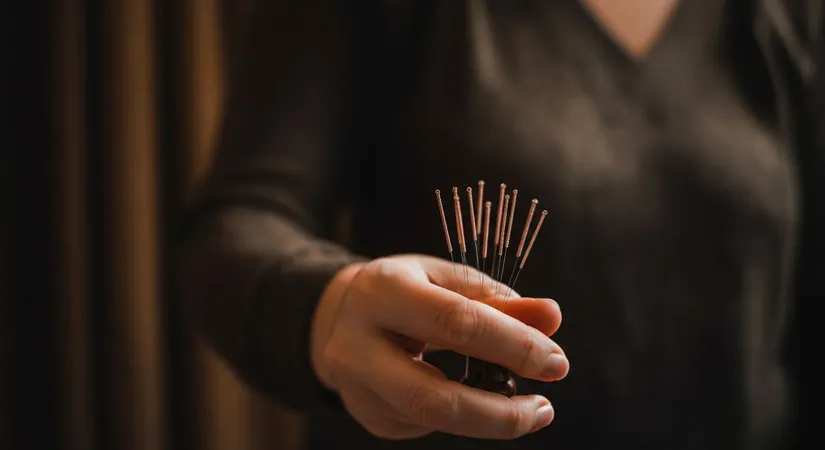Acupuncture Needles: A Deep Dive into Their Types and Uses
Discover the intricacies of acupuncture needles, exploring their types, uses, and why they are essential in natural pain relief.
In recent years, acupuncture has become an increasingly popular alternative therapy, highly regarded for its ability to relieve pain and promote overall well-being. Central to this ancient practice is the acupuncture needle, a tool as versatile as it is effective. As you dive into this topic, it is essential to understand not only what acupuncture needles are made of but also the various types available and their unique applications. From beginners seeking natural pain relief solutions to seasoned practitioners looking to refine their techniques, this guide offers valuable insight into the world of acupuncture needles.
Understanding Acupuncture Needles: What Are They Made Of?
Material Composition and Its Importance
Acupuncture needles are crafted primarily from stainless steel, a choice that ensures both durability and effective sterilization. This material selection is crucial for preventing allergic reactions, which can occur with other metals. Additionally, stainless steel offers the necessary balance between flexibility and rigidity, essential for precise needle insertion and manipulation during acupuncture sessions.
While the needle's body is universally made of steel, handles may vary in material, including copper or plastic. This variation allows practitioners to choose based on personal preference or specific procedural needs. The steel body ensures that the part of the needle entering the skin remains clean and precise, supporting the therapeutic outcomes of acupuncture.
Types of Acupuncture Needle Handles
- Copper Handles: Known for their traditional use, copper handles provide a classic feel and are often preferred by experienced practitioners.
- Plastic Handles: These are lightweight and offer a modern alternative, often used in disposable needle designs for convenience.
- Stainless Steel Handles: These offer a seamless design with the needle body, providing uniformity and ease of sterilization.
Steps to Ensure Safe Use of Acupuncture Needles
- Selection: Choose needles made from high-quality stainless steel to ensure safety and effectiveness.
- Sterilization: Always use pre-sterilized needles or sterilize them before use to prevent infections.
- Handling: Handle needles with care, using appropriate techniques to maintain their integrity and ensure patient comfort.

Exploring Different Acupuncture Needle Types and Their Benefits
Diverse Needle Types for Specific Therapeutic Applications
Acupuncture needles come in various forms, each tailored to meet distinct therapeutic needs. Filiform needles, the most prevalent type, are versatile and suitable for numerous acupuncture points. These needles are typically used for general treatments, offering flexibility in addressing a wide range of conditions.
Intradermal needles, shorter in length, are ideal for sensitive areas and are particularly effective in treating migraines and musculoskeletal pain. Their design allows for minimal discomfort while providing targeted relief, making them a preferred choice for delicate applications.
Press needles are another specialized type, often utilized in auricular acupuncture. These needles provide prolonged stimulation, beneficial for managing anxiety and sleep disorders. Their unique design ensures continuous therapeutic effects, enhancing the overall treatment experience.
Benefits of Different Acupuncture Needle Types
- Filiform Needles: Versatile and widely used, suitable for various acupuncture points and conditions.
- Intradermal Needles: Ideal for sensitive areas, effective in treating migraines and musculoskeletal pain.
- Press Needles: Provide prolonged stimulation, beneficial for anxiety and sleep disorders.
Choosing the Right Needle for Your Needs
- Identify the Condition: Determine the specific ailment or area requiring treatment to select the appropriate needle type.
- Consider Sensitivity: Choose needles based on the sensitivity of the treatment area, opting for intradermal needles for tender spots.
- Evaluate Treatment Goals: Align needle selection with desired therapeutic outcomes, such as prolonged stimulation or general relief.

How to Use Acupuncture Needles Safely and Effectively
Ensuring Patient Safety and Comfort
Safety is paramount when it comes to acupuncture needle use. Practitioners must adhere to strict sterilization procedures to prevent infections. This involves using pre-sterilized needles or ensuring proper sterilization before each session. Maintaining a sterile environment is crucial for patient safety.
Understanding anatomy and meridian pathways is essential for effective needle insertion. Practitioners should be well-versed in these areas to avoid adverse effects. The insertion should be gentle and precise, ensuring that the needle is placed correctly to maximize therapeutic benefits.
Gauging the patient's sensory feedback is another critical aspect. Practitioners need to be attentive to the patient's responses to ensure comfort and effectiveness during therapy. This involves adjusting techniques based on feedback to enhance the overall experience.
Key Practices for Safe Acupuncture Needle Use
- Strict Sterilization: Always use pre-sterilized needles or sterilize them before use to prevent infections.
- Precise Insertion: Ensure gentle and accurate needle placement to avoid adverse effects and enhance therapeutic outcomes.
- Patient Feedback: Continuously monitor and respond to patient feedback to maintain comfort and effectiveness.
Steps for Effective Acupuncture Therapy
- Preparation: Set up a sterile environment and ensure all equipment is properly sanitized.
- Technique: Use precise insertion techniques, considering the patient's anatomy and meridian pathways.
- Monitoring: Observe patient reactions and adjust techniques as necessary to ensure comfort and effectiveness.
Acupuncture Needles for Pain Relief: A Natural Solution
Understanding the Mechanism of Pain Relief
Acupuncture needles are strategically inserted into specific points on the body to alleviate pain. This process stimulates the release of endorphins, which are natural pain-relieving chemicals produced by the body. These neurotransmitters help reduce pain perception, providing relief without the need for pharmaceuticals.
Additionally, acupuncture promotes the balance of 'Qi,' or vital energy, within the body. According to traditional Chinese medicine, disruptions in Qi flow can lead to pain and illness. By restoring balance, acupuncture helps to address the root causes of pain, offering a holistic approach to treatment.
Research has shown that acupuncture can be particularly effective for chronic pain conditions such as arthritis, migraines, and lower back pain. This makes it a valuable tool for individuals seeking long-term pain management solutions without the side effects associated with medication.
Types of Pain Alleviated by Acupuncture
- Chronic Pain: Effective for conditions like arthritis and fibromyalgia, providing sustained relief.
- Migraines: Helps reduce the frequency and intensity of migraine attacks.
- Musculoskeletal Pain: Addresses issues such as lower back pain and neck stiffness.
Steps to Enhance Pain Relief with Acupuncture
- Assessment: Conduct a thorough evaluation to identify pain sources and tailor treatment.
- Targeted Insertion: Use precise needle placement to stimulate specific acupuncture points for optimal relief.
- Regular Sessions: Schedule consistent treatments to maintain pain relief and improve overall well-being.
Advanced Acupuncture Needle Technologies for Enhanced Therapeutic Outcomes
Ensuring Safe and Effective Acupuncture Practices for Optimal Patient Care
Frequently Asked Questions
What are acupuncture needles made of?
How do acupuncture needles work for pain relief?
Are acupuncture needles safe to use?
What are the different types of acupuncture needles and their benefits?
How can beginners choose the best acupuncture needles?
Discover the Path to 'Healthy Beauty' with estethica's Expert Care. Call Now for Your Free Consultation!
📞 Speak to Our Specialists Today!